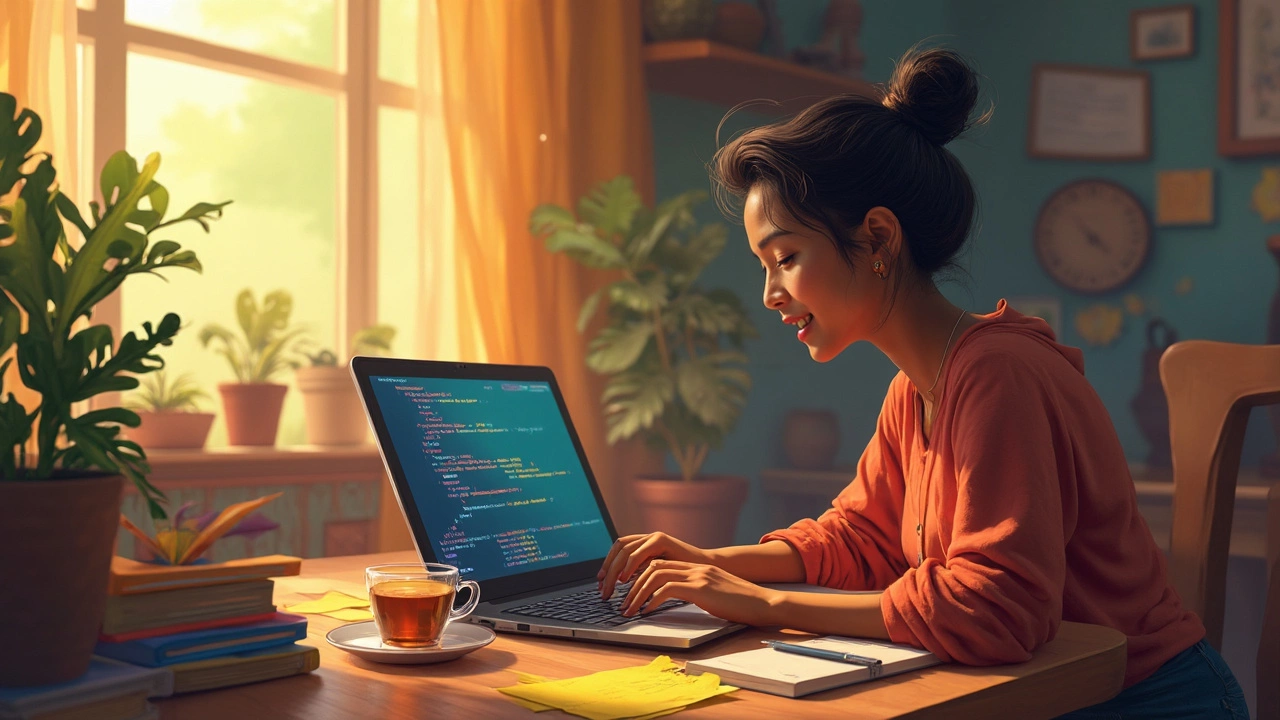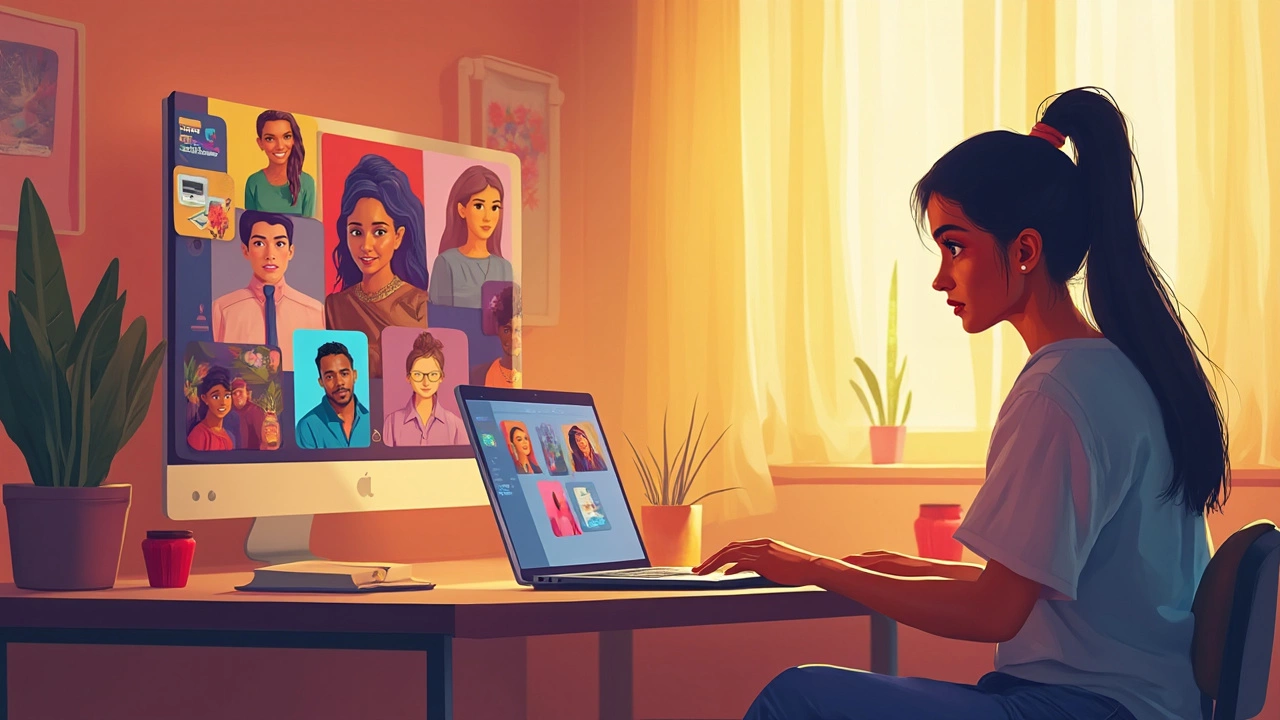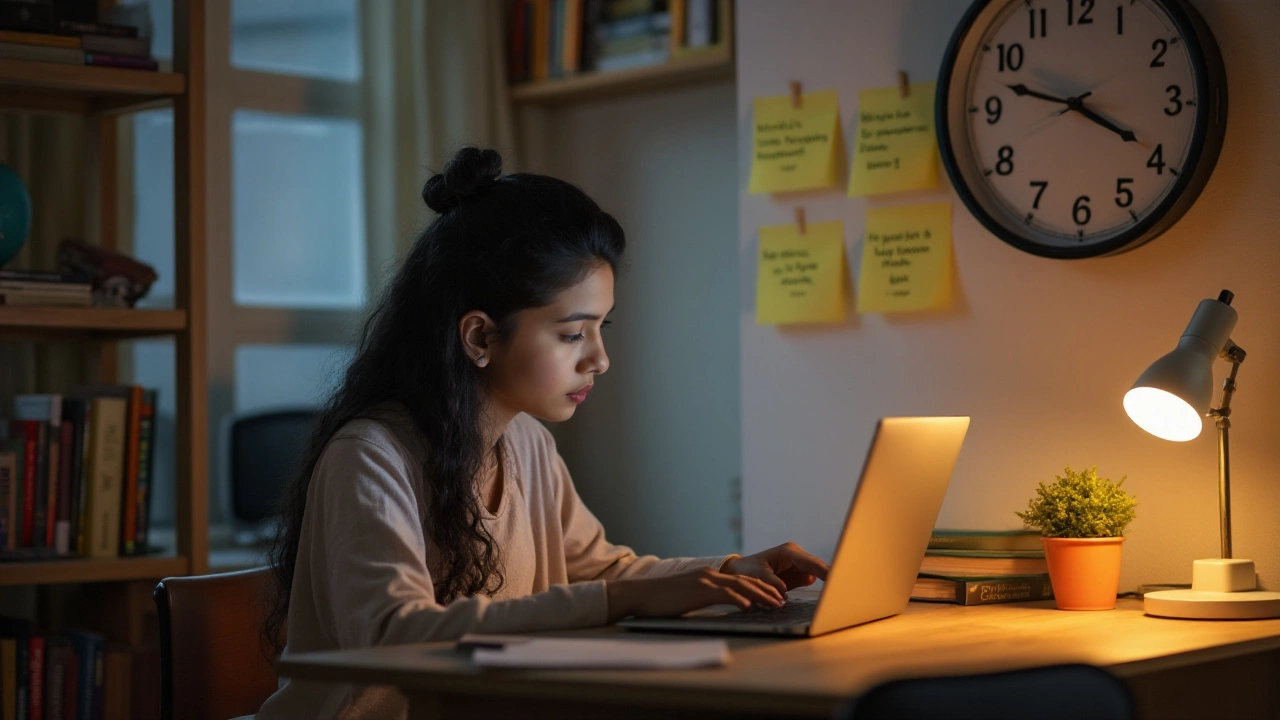You don’t need a fancy laptop to start coding. Any regular computer will do—most pro coders started with what they already had at home. The trick is to stop overthinking and just pick a language. Seriously, there's no perfect first one. If you're aiming for websites, try HTML, CSS, and JavaScript. Want to build apps? Python makes things super simple. Here’s a cool fact: Python’s syntax is so straightforward, even middle schoolers around the world use it to make their own games and websites.
Next, skip downloading a bunch of confusing software. Sites like Replit or Codecademy let you write and run code right in your browser. No setup stress. You can start coding in one tab and binge-watch coding tutorials in the other. If you're a fan of checking things off lists, free courses like freeCodeCamp walk you through real mini-projects, step by step.
- Pick Your First Programming Language
- Set Up Your Coding Space
- Dive Into Hands-on Practice
- Stay Motivated and Keep Learning
Pick Your First Programming Language
Kicking off your coding journey starts with a simple choice, but it doesn’t have to be stressful. Think about what you want to build. Want to make a website? JavaScript is your sidekick. More interested in data science or automation? Python is stupidly popular and readable. Even if you make the "wrong" choice, remember: switching languages later is way easier after you know the basics of any one language.
Let’s break it down:
- Python: Runs everything from Netflix’s servers to small robots. Friendly for beginners. Check out its super clear syntax—no need to mess with confusing brackets everywhere.
- JavaScript: Runs right in your web browser. If you like seeing instant results, you can tinker with it using developer tools in Chrome or Firefox.
- HTML & CSS: These aren’t real programming languages, but you can’t make a modern web page without them. Think of them as the building blocks for anything visual on the web.
- Scratch: Sounds toy-like, but it’s used in schools globally for teaching logic. You drag blocks instead of typing, so you get the core ideas before jumping into typed code.
Now, people sometimes ask, "Which language is most in-demand right now?" Here’s what’s trending in 2025:
| Language | Beginner-Friendly? | Main Use |
|---|---|---|
| Python | Yes | Web, automation, AI |
| JavaScript | Moderate | Web, apps |
| SQL | Pretty easy | Databases |
| Java | So-so | Apps, enterprise |
The big thing: Don’t spend weeks researching. Just pick one from this list, set a simple goal (like "make a calculator"), and go for it. Real progress in coding for beginners comes from building, not reading endless articles about which language is best.
Set Up Your Coding Space
Getting your start coding journey moving means carving out a spot where you can actually focus. You don’t need a tech cave—just a quiet table, desk, or even a cleared-off corner will do the trick. Keep your essentials close: your computer, charger, maybe a notepad to jot things down quickly. Most beginners underestimate how much distractions slow them down, so set your phone away and pick a spot with good lighting. That YouTube cat video can wait.
If you want to code offline, you’ll need a code editor. VS Code is a popular pick and totally free. It works for almost every coding for beginners language: Python, JavaScript, HTML, you name it. It also has built-in tips and color highlights that make reading code way easier. According to Stack Overflow’s 2024 developer survey, "over 73% of new coders prefer using VS Code or web-based editors for their projects." That’s a huge chunk, and there’s a reason for it—the setup’s just simple and helps you spot errors fast.
Try this checklist when building your coding setup:
- Pick a comfy chair: Back pain is not a badge of honor. Sit straight, and thank yourself later.
- Use headphones: Block out noisy roommates or street sounds.
- Install a code editor: Try VS Code or Sublime Text. Both are free and run on any computer.
- Bookmark online coding sites: Keep links to Replit, Codecademy, or freeCodeCamp for quick access.
- Set short timers: Try 25-minute bursts of work (Pomodoro style) with 5-minute breaks.
The right workspace isn’t about being perfect—it's about removing just enough friction that you’ll keep coming back tomorrow. As
Bill Gates once said, "Your most unhappy customers are your greatest source of learning." In coding, your biggest headaches turn into your best breakthroughs—if you stick with it.
If you like numbers, here’s a quick look at popular starter tools in 2024:
| Tool | Beginners Using (%) |
|---|---|
| VS Code | 73 |
| Replit | 58 |
| freeCodeCamp | 62 |
Pick what works for you and don’t sweat the fancy stuff. The best coding classes always start with a workspace where you actually want to sit and type for a while.

Dive Into Hands-on Practice
Talk is cheap—actual coding is where the magic happens. If you truly want to start coding, you need to type stuff out and see it explode (sometimes literally) on your screen. Watch fewer videos. Type more lines yourself. You’ll learn ten times faster fixing your own code than just following along with someone else's solution.
Here’s what works for beginners: start with bite-sized projects. For coding for beginners, classic projects are a basic calculator, a to-do list, or even a super simple website with your favorite memes. The real win? You can see your progress in real time. Get your code working, then break it on purpose—mess with it. This is how you start thinking like a developer.
When you hit an error, don’t freak out. Googling bugs is basically a life skill for developers. Make your first stop Stack Overflow—someone, somewhere, has already wrestled with your exact problem.
If motivation is hard, join coding challenges like 100 Days of Code or look for "beginner-friendly" project lists on GitHub. They nudge you to build, not just consume info. And if group learning helps, most coding classes have built-in coding sandboxes and forums where you can share your scripts and get instant feedback. That back-and-forth makes concepts stick way better.
- Start small. Complete something, no matter how basic.
- Try lots of little experiments. Test out ideas—messing up is part of the deal.
- Repeat. Coding is like getting good at a sport—the more reps, the quicker the skills.
Want some real numbers? According to a 2024 study by Codecademy, students who built three or more mini-projects in their first month were 40% more likely to stick with programming than those who just watched videos.
So, get your hands dirty. Practice, break things, and actually finish what you start. That's how you get good—fast and for real.
Stay Motivated and Keep Learning
Coding can get frustrating—everyone hits bugs and makes weird mistakes. But consistency pays off. Here’s something legit: most people who stick with coding practice at least 20 minutes a day, not hours at a time. Short, regular sessions beat a weekly binge, and help your brain actually remember stuff.
Your first win? Build something simple with start coding basics. For example, make a calculator, personal site, or even a silly game. Real projects are way more fun than copying lines of code without knowing what’s happening. When you get stuck (which is totally normal), use sites like Stack Overflow or the r/learnprogramming subreddit. There are thousands of beginners figuring things out just like you.
Challenge yourself now and then. Try coding challenges on HackerRank or LeetCode. You don’t have to ace them—just learning a new way to solve stuff is a win. Some coding classes even offer certificates if you finish, which look cool on resumes or LinkedIn.
- Join a coding community or class—don't do it all solo.
- Share your projects with friends, even if they're tiny.
- Track what you’ve learned in a simple notebook or digital doc.
- Set small goals: "I’ll solve two easy problems this week."
Here’s a quick look at why steady practice beats cramming:
| Practice Style | Long-term Progress |
|---|---|
| 20-30 mins daily | Strong skill building |
| 3 hrs once a week | Slower progress |
Stick with it—every pro coder started by Googling simple stuff way more than they want to admit. Your coding journey is personal, but you don’t have to figure it out alone. The best part? The more you practice, the less scary it all feels.


